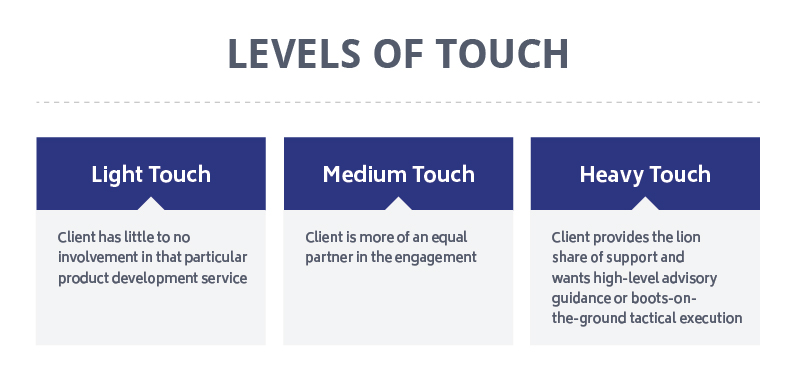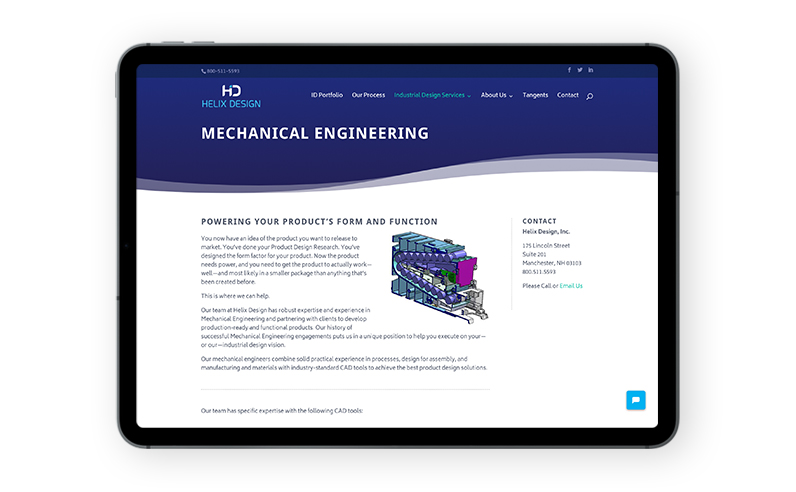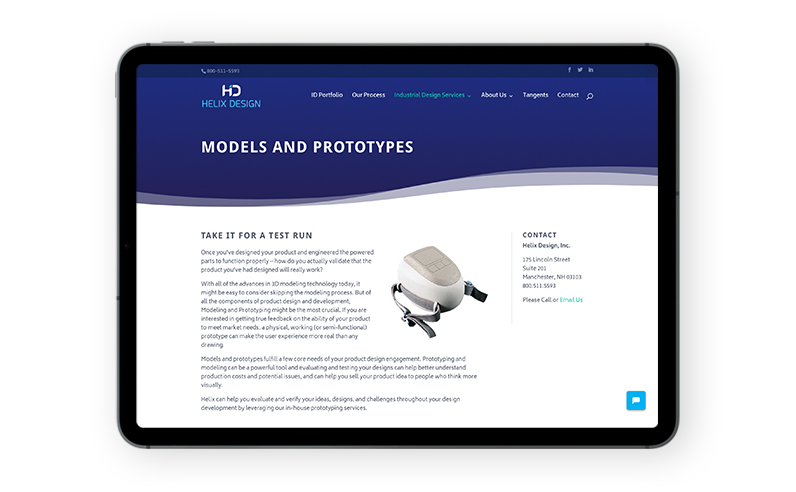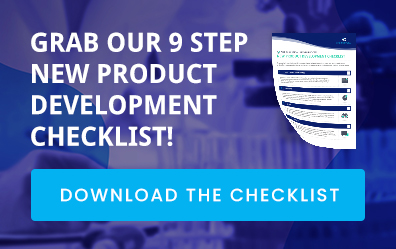Tangents
Levels of Touch: The Ways Clients Leverage Outsourced Product Development Services
by Joe Schappler

[wtr-time]
Exactly how much you need/work with your outsourced industrial design partner can impact the success of your project.
Different internal design teams have different needs and different expectations when using a partner for product development services. Some prefer an intensive hands-on approach, while others prefer a light—or little-to-none—approach to working with an industrial design partner.
We broke down the core services that your typical industrial design firms provide, and went through each in sequence, highlighting how each of the “levels of touch” can impact your project.
These levels of touch are:
- Light – Client has little to no involvement in that particular product development service
- Medium – Client is more of an equal partner in the engagement
- Heavy – Client provides the lion share of support and wants high-level advisory guidance or boots-on-the-ground tactical execution
While many of the product development services we outline here overlap or include inputs from other services, for ease of use, we’ll address some core industrial design solutions as if they were to stand alone.
Design Research
Design research is the function of collecting the voice of your customer information. According to The Atlantic, “Design can exist without ‘the research.’ But if we don’t study the world, we don’t always know how or what to create.”
The article expands on the value of Design Research, including learning about customer’s behavior, understanding and analyzing culture, defining context, and setting focus.
Design research helps to remove subjectivity and add guidance to the development process based on the data that’s uncovered.
Design Research with a Light Touch
Some companies just aren’t interested in being heavily involved in Design Research. They have information from their marketing group, and they don’t believe any additional voice of customer data is necessary. Or they may think it’s not practical to go out and get “voice of the customer” information due to a limited time in the schedule, or limited budget.
In this case, the responsibility of the industrial design team is to take what information is available and use it as guidance in development.
At times, we hear conflicting information from key decision-makers in a company. This could happen during a kickoff meeting, or even during one of our sales meetings. When this occurs, we suggest conducting one-on-one interviews with each of the key decision-makers to find out what their individual expectations might be for the project. Their expertise in their field can provide valuable data to the development team.
We usually receive very different ideas and expectations coming from this exercise, and it’s often in conflict with the provided marketing information. So we take this data, analyze and summarize it back to them in a non-biased comprehensive document that communicates the conflicts and differing expectations.
This then generally causes a whole new sprint of activity and “infighting” that is healthy and necessary to resolve before a productive design development effort can get underway. We brainstorm with this team of influencers and search out understandings about their specific expectations or desires for this product.
The goal is in getting everybody on the same page with expectations all in alignment. We lead this effort and share paths and ideas to uncover a middle ground compromise that can lead toward a successful product solution.
Design Research with a Mid to Heavier Client Touch
In other cases, you might have a client that is unsure about their customers. Maybe it’s a new technology where there are no or few products out there like it right now, or they just want to learn more about their existing customers so they can do a better job of meeting their needs.
In these cases, we suggest a design research phase where we will go out and gather “voice of the customer” data. We may utilize our staff for this effort, or we may work with one of our research partners depending on the scope.
This might take place in different parts of the country to deal with different locations and even different demographics. The effort can include one-on-one interviews, group discussions, surveys, observation in the customer’s environment, or a myriad of other techniques.
The goal is to really get a better understanding of the potential customers so that the team can define a product with the customer that more accurately meets their needs and desires. The resulting data provides objectivity to the development process and gives a clear understanding of the project goals.
While this level of Design Research requires more investment and more time, it can improve the chances of success in the marketplace. When it happens, it’s a win-win situation for both the customer and the company.
Finally, it’s also important to note that not every type of product warrants this kind of expenditure— this part of the process is done on a case-by-case basis.
Industrial Design
In industrial design, the goal is to define the optimal user experience of a product. This includes aesthetics, branding, user interface and ergonomics.
Industrial Design with a Light Touch
In some cases, you have clients who are not overly sensitive to the product’s appearance for a variety of reasons. Generally speaking, they still want it to look reasonably nice and designed to be appropriate for the target market.
In that case, it’s a pretty straight-forward process. But we still need to understand the customer and how they use the product, the environment it’s to be used in and other attributes necessary for the product to be successful. Then we’ll approach the design effort in a limited way, perhaps exploring only a few alternate directions.
Industrial Design with a Mid to Heavier Client Touch
Highly competitive products require us to put more emphasis on meeting the needs of the user and a deep understanding of the user environment to design a successful solution.
Given this, we have to understand the competition. We have to go out and really do some homework and find out what the competition is offering. We will then develop industrial design solutions that compete with the best in class.
Unlike in the first situation, here we aim to really understand the competitive landscape and design so that the product will succeed in the best possible way. Product branding is also going to be very important in this type of an effort to promote the company image for customer loyalty— today’s customers are very brand conscious.
In some cases, a company’s culture may be to be the “leader of the pack” with the best technology, best design and branding. They may have less concern about what their competitors are doing as long as they stay one step ahead. They are the leaders in the market, have the top products and want everybody else chasing them. These companies set the benchmark for the industry.
This is where we’re going to do a whole slew of design possibilities and funnel them into the most promising directions.
The idea is to shoot ahead of the competition by matching technology with the latest design trends. This is where we can be very innovative, push the envelope and create an innovative design setting the solution apart from the competition and truly embracing the user experience.
Products designed in this manner can benefit significantly when matched up with a design research effort.
Mechanical Design
Mechanical design is done in conjunction with Industrial Design. For this, we’re really looking at the nuts and bolts of how products can be made, how to assemble, what materials make sense, regulatory compliance and what manufacturing processes should be used.
Mechanical Design is when the desired result is to deliver a solution that can be made with mass production. The end result is to get production documentation that you can release to manufacturing.
This is where it gets real.
Mechanical Design with a Light Touch
In light touch cases, clients generally want to redesign, update and perhaps make a product look better. Whatever it is, it’s generally an update to existing product lines. They might have new technology, but it’s not a ground-breaking advancement.
In some of these cases, there are clients who are not overly sensitive to the product’s appearance—it matters less to them. The user interface may already be acceptable but the need to update may be based on other issues, such as components going obsolete.
Regardless, we’re not engaged in a significant overhaul but more of an improved iteration. In these cases, it’s important to keep it simple.
It’s a more basic approach where a client may say, “Look, we’re okay with exposed fasteners. We don’t care about that kind of stuff. It’s not a real aesthetically sensitive environment that our product is going to be used in, and it’s a low volume number of units.”
There may not be any regulatory requirements that need to be met on this type of product. Or hardware components might be known and provided. This is an important item as it can drastically reduce development time and required client interaction. The more defined the hardware components are the less back and forth and re-do there is in the process.
The concern is with keeping the capital costs under control and getting the new product out quickly, without taking on unnecessary design risks.
Ultimately in these cases, there aren’t a lot of interactions required for success. Because there are fewer risk areas because of less change, this type of mechanical design can progress quickly to success.
Mechanical Design with a Mid to Heavy Touch
On the other hand, there are products that are critical to a client’s success and are more than just an iterative update. More attention needs to go into the mechanical design.
Perhaps the client doesn’t want to see any screws or exposed fasteners on the user-facing surfaces. There might even be a need for sealing the product for ingress protection from water or dust. Or perhaps there are other requirements to address—depending on the product’s environment— to ensure performance goals are being met for user expectations. There may also be ruggedization requirements meaning material studies need to be done.
There will be considerable detailed work and creative, innovative engineering into how this product is going to be put together to meet the product requirements.
In this type of situation, there’s usually considerable interaction with the hardware team going back and forth to make sure the effort is in alignment with the requirements so that the enclosure design meets the performance goals.
Mechanical Design for High Volume or Cost-Sensitive Products
In addition to what we’ve covered above, there’s a third situation that doesn’t fit neatly into the other two categories, and that’s high volume/cost-sensitive mechanical design.
In this third case scenario, assembly time is critical to product margins, so we want to reduce production build time as much as possible. We may have to make more rigorous and ingress standards for extreme environmental conditions, which may require repeated testing with prototypes to resolve. We may also have to work with regulatory labs to meet ingress protection requirements with first article parts.
During these projects, often the hardware team is working at the same time as the mechanical designers. So significant collaboration is necessary between the teams to avoid any surprises and confirm that all requirements are being met.
For projects like these, weekly formal meetings are helpful to keep all teams in alignment. There may be additional interaction throughout the week between hardware engineering and mechanical designers, as both of these efforts may be running in parallel.
Prototyping
The final product development service we’ll cover is prototyping.
Prototyping is really used in all of the other product development services we’ve talked about. Prototypes can be simple mock-ups for learning and communicating in the industrial design phases, or they can be functional evaluation prototypes used in the engineering phases. They can be full-scale appearance models for final product approvals, marketing needs and field testing.
We are really big believers in getting ideas into physical forms as quickly as possible— we learn continuously using this essential tool.
Different projects, however, require different types and amounts of prototypes.
Prototyping with Low Touch
In the cases of the low-risk designs we mentioned earlier, we may only need to do a single prototype to verify assembly and that the hardware fits and all the parts go together like intended.
This could occur with a simple product and it’s not one that would normally need a high level of finish. An unfinished prototype would be used internally to evaluate and verify the product requirements.
Prototyping with Mid Touch
More complex designs might require mock-ups in the early phases and then multiple evaluation prototypes, 3D printed or machined, cast or fabricated during the development.
This usually ends with a finished appearance representative prototype that might be used for management, marketing and other approvals. A handheld product fits in this situation, where we might need an ergonomic evaluation. So we would create several soft foam or 3D printed models with different form factors that could be used to gather user feedback on the ergonomics—especially if that’s critical to the success of the product.
There may also be moving mechanical parts that have to be tested out, like hinges or other kinds of mechanisms. That would be more work for this type of project with more complex moving parts and might require a significant prototyping budget.
But issues get resolved much more quickly when we do prototype than when we don’t, so we constantly promote extensive prototyping to solve complex mechanical issues.
Prototyping with Heavy Touch
For even more complex products, like those with ingress and drop protection requirements we mentioned above, we might end up developing multiple prototypes just for this testing. Much can be learned and refined during this effort to avoid issues later in production.
At this level, we might develop prototypes for appearance to present at trade shows, for input, photography, and other marketing needs. At Helix, we sometimes test first article parts off tools, using these for ingress testing because there’ll be in the production materials that have the designed-for performance characteristics.
Are You Considering Outsourcing Product Development Services?
If you have too many projects on your plate, don’t have enough internal industrial or mechanical designers on hand, or you just want an outside perspective, we can help.
As a place to start, download our 9 STEP NEW PRODUCT DEVELOPMENT CHECKLIST today.
About Helix Design
Helix Design is an industrial design firm and product design company that delivers creative design and mechanical engineering solutions to companies who need external perspectives combined with practical experience. For samples of our recent work, please visit our industrial design portfolio.
Do you need industrial design guidance for your next project?
Contact us for an assessment today.





